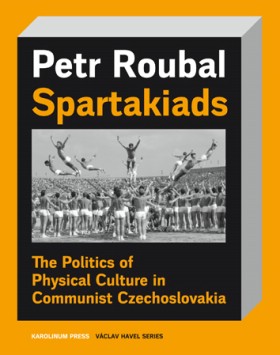Spartakiads - The Politics of Physical Culture in Communist Czechoslovakia
Petr Roubal
Spartakiads
The Politics of Physical Culture in Communist Czechoslovakia
Every five years from 1955 to 1985, mass Czechoslovak gymnastic demonstrations and sporting parades called Spartakiads were held to mark the 1945 liberation of Czechoslovakia. Featuring hundreds of thousands of male and female performers of all ages and held in the world’s largest stadium—a space built expressly for this purpose—the synchronized and unified movements of the Czech citizenry embodied, quite literally, the idealized Socialist people: a powerful yet pliant force directed by the regime.
In this book, Petr Roubal explores the political, social, and aesthetical dimensions of these mass physical demonstrations, with a particular focus on their roots in the völkisch nationalism of the German Turner movement and the Czech Sokol gymnastic tradition. Roubal draws on extensive interviews and archival research to investigate the many facets of this sporting tradition, from the reactions of ordinary, non-political gymnasts who appropriated and challenged official rituals to the organizational demands of the Spartakiads, such as the incredible finances involved and the knowledge and skills required from hundreds of former Sokol officials. Featuring an abundance of archival photographs, Spartakiad takes a new approach to Communist history by opening a window onto the mentality and mundanity behind the Iron Curtain.
Contents:
Acknowledgements
Preface
A GENEALOGY OF THE SPARTAKIADS
Ideology of the Organicism and Beginnings of the Mass Gymnastic Performances
A Physical Sonderweg and the Post-1848 Turner Movement
The Turners and the Third Reich
The Political Aesthetics of Tyrš’s Project
Sokol Slets Prior to the First World War
Segregation as Emancipation
The Mystery of Democracy – Slets during the First Republic
Strahov Stadium
Transformations in Slet Symbolism
The Left and Mass Gymnastics
The Communist Party and Sokol after the Second World War: the Search for a Common Denominator
The All-Sokol Slet of 1948 – “Can the People Betray?”
SYMBOLISM OF THE FIRST SPARTAKIAD IN 1955
Stalinism without Stalin
“Socialism Is a Child.” School and Junior Days
A New Shift Begins
The Unbearable Heaviness of Folklore: Folk Dance and Spartakiads
Sokol Members from the Factories and Offices
Performances of the Armed Forces
SPARTAKIAD SYMBOLISM DURING THE “NORMALIZATION” ERA
Spartakiads with a Human Face
“Normalization” Spartakiads as an Image of Social Cohesion
Parents and Children Performing Exercises
An Amiable Background: Female Performances at Spartakiads during the “Normalization” Era
Junior Women and “Buds”
Soldiers and the Crisis of Masculinity
A Return to Sokol
THE ORGANIZATION OF SPARTAKIADS
Professional Discourse
The “Call to Arms” for the 1st All-State Spartakiad in 1955
A Return to a Tried-and-True Practice
Spartakiad Five-Year Plans
Physical and Ideological Training for the Spartakiad
Spartakiad Participants in Prague: Transportation, Accommodation and Food
The Disciplinary Space of Strahov Stadium
The Budget of Spartakiads in the Moral Economy of State Socialism
SOCIETY AND SPARTAKIADS
Open Resistance
Weapons of the Weak
Spartakiad Potlatch
An Enthusiastic Reception
Conclusion
APPENDIX
Bibliography
List of Illustrations
Index
Karolinum, Prague 2020, 424 pages, 150 x 190 mm, ISBN 978-80-246-3851-5
Spartakiads
The Politics of Physical Culture in Communist Czechoslovakia
Every five years from 1955 to 1985, mass Czechoslovak gymnastic demonstrations and sporting parades called Spartakiads were held to mark the 1945 liberation of Czechoslovakia. Featuring hundreds of thousands of male and female performers of all ages and held in the world’s largest stadium—a space built expressly for this purpose—the synchronized and unified movements of the Czech citizenry embodied, quite literally, the idealized Socialist people: a powerful yet pliant force directed by the regime.
In this book, Petr Roubal explores the political, social, and aesthetical dimensions of these mass physical demonstrations, with a particular focus on their roots in the völkisch nationalism of the German Turner movement and the Czech Sokol gymnastic tradition. Roubal draws on extensive interviews and archival research to investigate the many facets of this sporting tradition, from the reactions of ordinary, non-political gymnasts who appropriated and challenged official rituals to the organizational demands of the Spartakiads, such as the incredible finances involved and the knowledge and skills required from hundreds of former Sokol officials. Featuring an abundance of archival photographs, Spartakiad takes a new approach to Communist history by opening a window onto the mentality and mundanity behind the Iron Curtain.
Contents:
Acknowledgements
Preface
A GENEALOGY OF THE SPARTAKIADS
Ideology of the Organicism and Beginnings of the Mass Gymnastic Performances
A Physical Sonderweg and the Post-1848 Turner Movement
The Turners and the Third Reich
The Political Aesthetics of Tyrš’s Project
Sokol Slets Prior to the First World War
Segregation as Emancipation
The Mystery of Democracy – Slets during the First Republic
Strahov Stadium
Transformations in Slet Symbolism
The Left and Mass Gymnastics
The Communist Party and Sokol after the Second World War: the Search for a Common Denominator
The All-Sokol Slet of 1948 – “Can the People Betray?”
SYMBOLISM OF THE FIRST SPARTAKIAD IN 1955
Stalinism without Stalin
“Socialism Is a Child.” School and Junior Days
A New Shift Begins
The Unbearable Heaviness of Folklore: Folk Dance and Spartakiads
Sokol Members from the Factories and Offices
Performances of the Armed Forces
SPARTAKIAD SYMBOLISM DURING THE “NORMALIZATION” ERA
Spartakiads with a Human Face
“Normalization” Spartakiads as an Image of Social Cohesion
Parents and Children Performing Exercises
An Amiable Background: Female Performances at Spartakiads during the “Normalization” Era
Junior Women and “Buds”
Soldiers and the Crisis of Masculinity
A Return to Sokol
THE ORGANIZATION OF SPARTAKIADS
Professional Discourse
The “Call to Arms” for the 1st All-State Spartakiad in 1955
A Return to a Tried-and-True Practice
Spartakiad Five-Year Plans
Physical and Ideological Training for the Spartakiad
Spartakiad Participants in Prague: Transportation, Accommodation and Food
The Disciplinary Space of Strahov Stadium
The Budget of Spartakiads in the Moral Economy of State Socialism
SOCIETY AND SPARTAKIADS
Open Resistance
Weapons of the Weak
Spartakiad Potlatch
An Enthusiastic Reception
Conclusion
APPENDIX
Bibliography
List of Illustrations
Index
Karolinum, Prague 2020, 424 pages, 150 x 190 mm, ISBN 978-80-246-3851-5

